Unit 4 Having fun Topic 1 第4课时 课件(仁爱科普版七年级上册)
文档属性
| 名称 | Unit 4 Having fun Topic 1 第4课时 课件(仁爱科普版七年级上册) |  | |
| 格式 | ppt | ||
| 文件大小 | 609.5KB | ||
| 资源类型 | 试卷 | ||
| 版本资源 | 仁爱科普版 | ||
| 科目 | 英语 | ||
| 更新时间 | 2023-07-24 16:13:43 | ||
图片预览

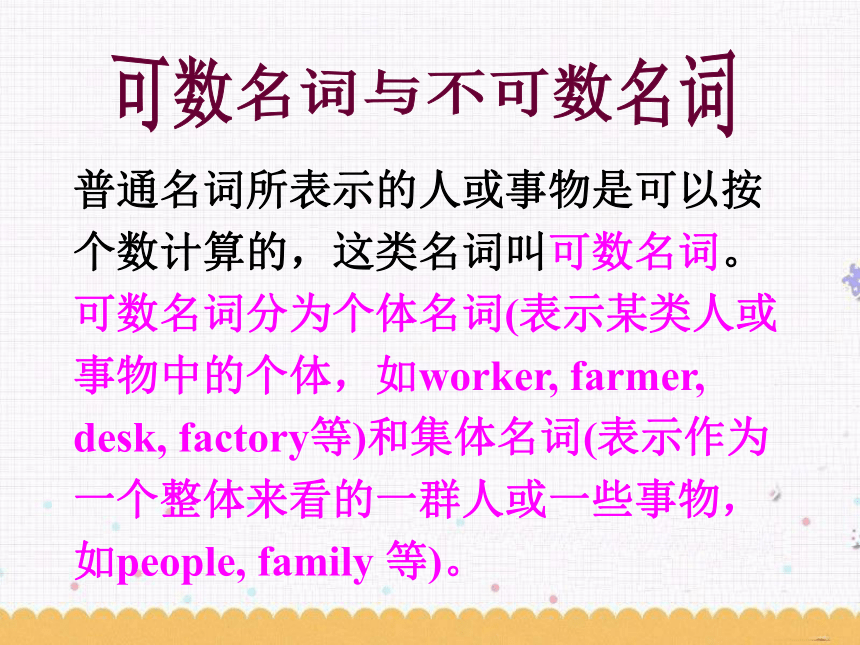

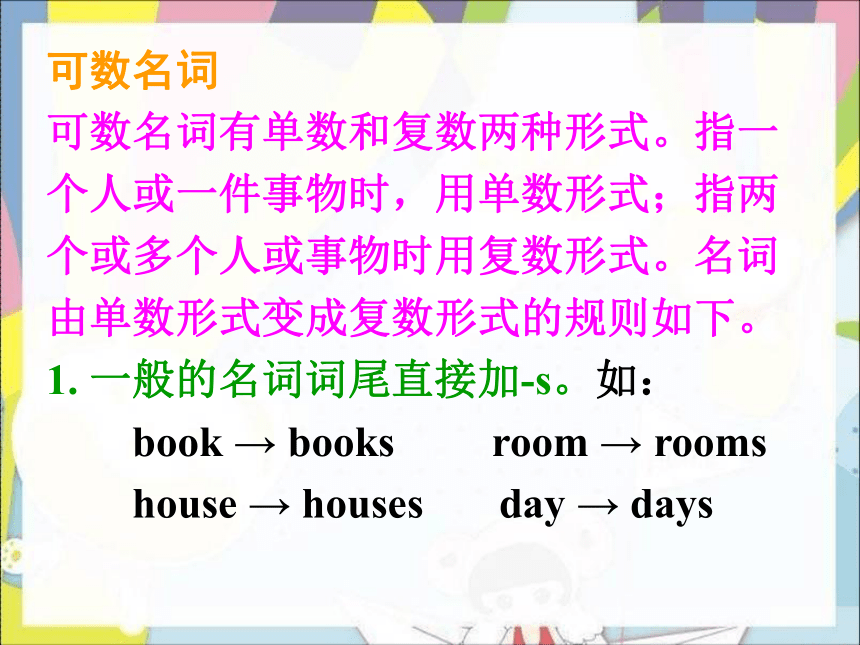
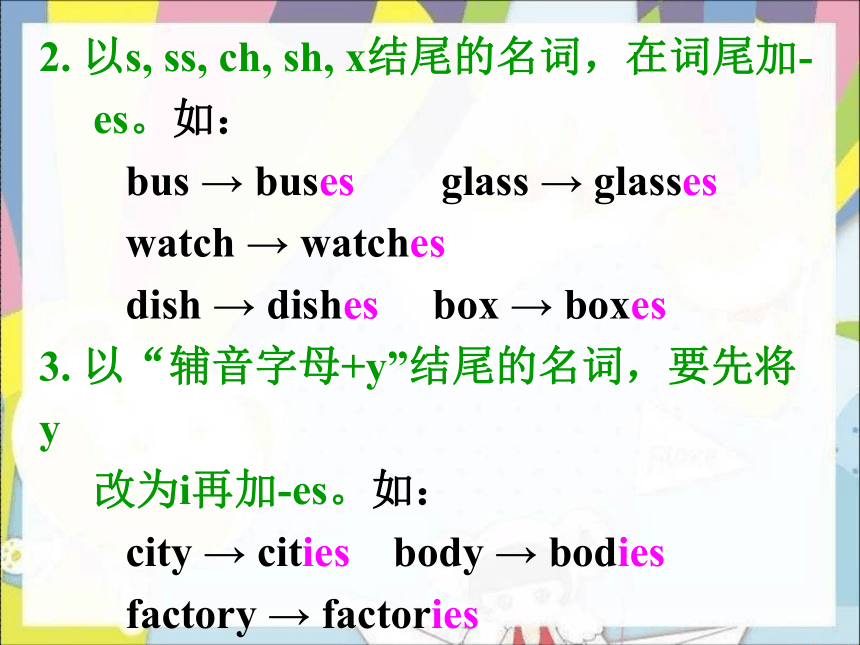
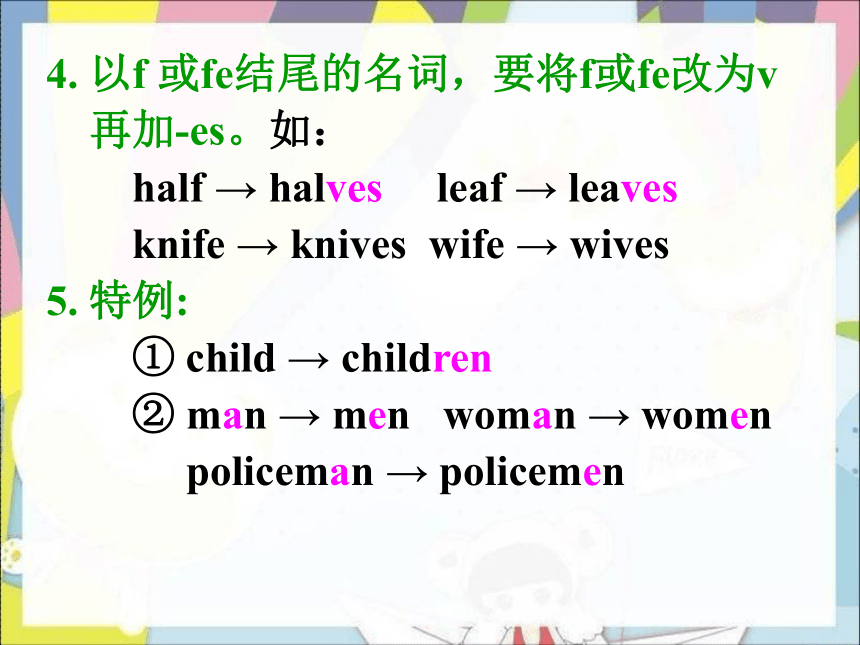
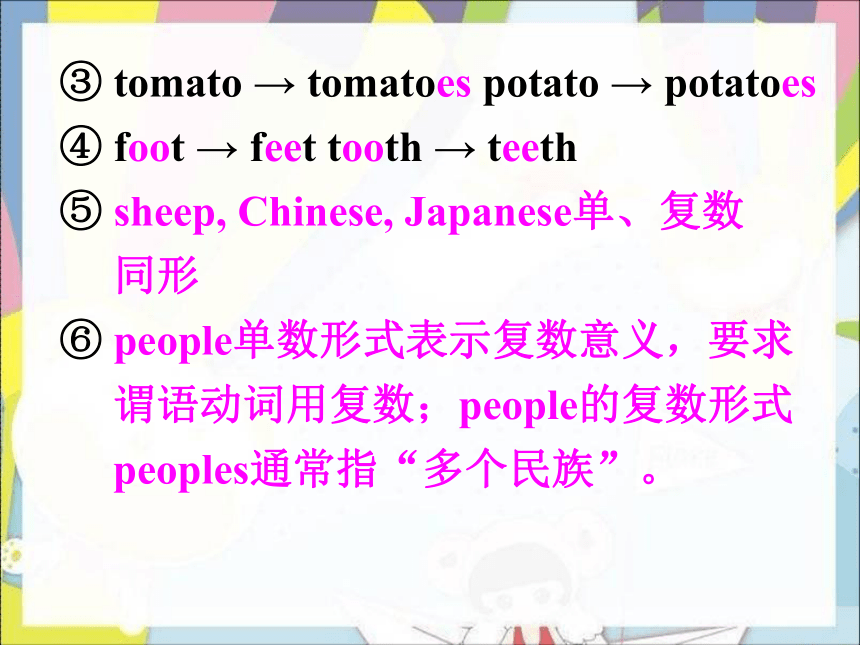
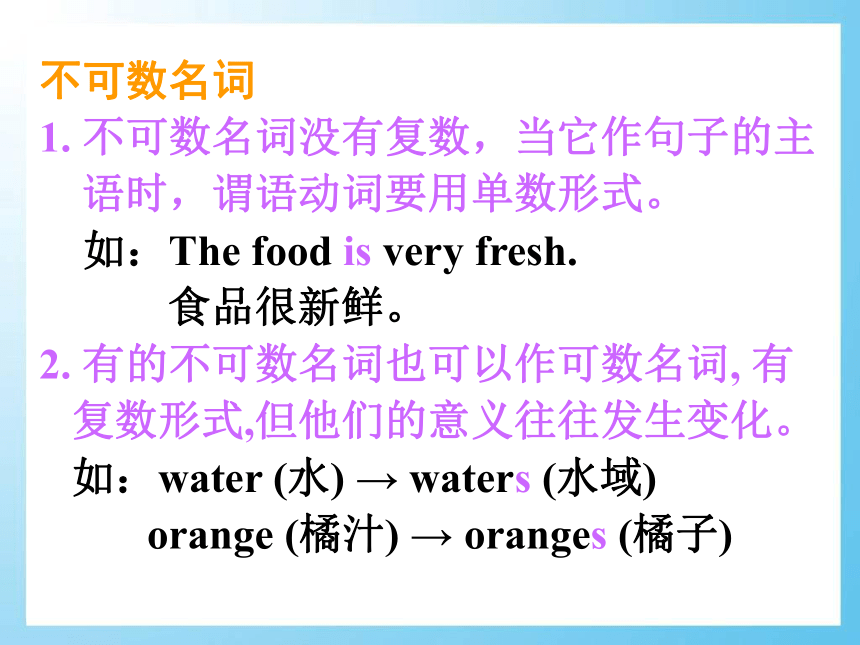
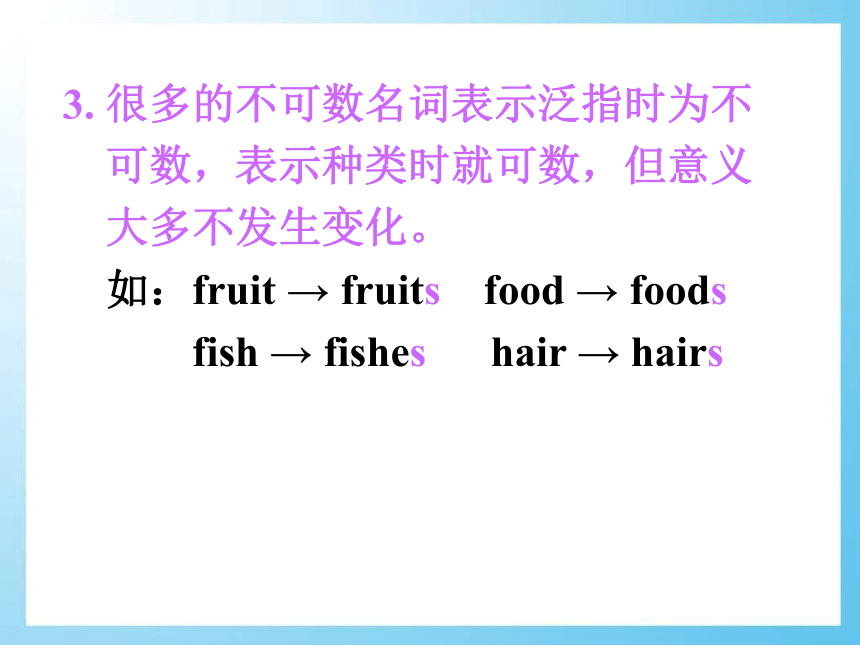
文档简介
(共20张PPT)
Unit4 Topic1 What can I do for you
普通名词所表示的人或事物是可以按个数计算的,这类名词叫可数名词。可数名词分为个体名词(表示某类人或事物中的个体,如worker, farmer, desk, factory等)和集体名词(表示作为一个整体来看的一群人或一些事物,如people, family 等)。
如果普通名词所表示的事物是不能按个数来计算的,这类名词就叫不可数名词。不可数名词分为物质名词(表示无法分为个体的物质,如meat, rice, water, milk等)和抽象名词 (表示动作、状态、情况、品质等抽象概念,如work, homework, time, health, friendship等)。
可数名词
可数名词有单数和复数两种形式。指一个人或一件事物时,用单数形式;指两个或多个人或事物时用复数形式。名词由单数形式变成复数形式的规则如下。
1. 一般的名词词尾直接加-s。如:
book → books room → rooms
house → houses day → days
2. 以s, ss, ch, sh, x结尾的名词,在词尾加-
es。如:
bus → buses glass → glasses
watch → watches
dish → dishes box → boxes
3. 以“辅音字母+y”结尾的名词,要先将y
改为i再加-es。如:
city → cities body → bodies
factory → factories
4. 以f 或fe结尾的名词,要将f或fe改为v
再加-es。如:
half → halves leaf → leaves
knife → knives wife → wives
5. 特例:
① child → children
② man → men woman → women
policeman → policemen
③ tomato → tomatoes potato → potatoes
④ foot → feet tooth → teeth
⑤ sheep, Chinese, Japanese单、复数
同形
⑥ people单数形式表示复数意义,要求
谓语动词用复数;people的复数形式
peoples通常指“多个民族”。
不可数名词
1. 不可数名词没有复数,当它作句子的主
语时,谓语动词要用单数形式。
如:The food is very fresh.
食品很新鲜。
2. 有的不可数名词也可以作可数名词, 有复数形式,但他们的意义往往发生变化。
如:water (水) → waters (水域)
orange (橘汁) → oranges (橘子)
3. 很多的不可数名词表示泛指时为不
可数,表示种类时就可数,但意义
大多不发生变化。
如:fruit → fruits food → foods
fish → fishes hair → hairs
名词可数不可数“几注意”
1. 可数名词是可以用来计数的名词。可数名词有单数和复数形式。如:desk-desks, apple-apples等。不可数名词是不可以直接用来计数的名词。不可数名词没有复数形式,如:some bread,a little milk等。
2. 可数名词和不可数名词前都可以用some, any, a lot of, lots of 等来修饰, 表示“一些,许多”。如:
There are some oranges on the desk. 桌子上有一些桔子。
There is a lot of water in the bottle. 瓶里有许多水。
3. 可数名词前可用具体的数词来表示具体的数量。如:two apples, four books等。不可数名词前通常用“单位词+of”来表示数量。如:a piece of paper等。
4. 对可数名词前的修饰语提问用how many; 对不可数名词前的修饰语提问用how much。 如:
How many apples are there in the box
How much tea is there in the cup
I. 请从各题后所给的选项中选出最佳选项。
( ) 1. —What do you think _____ the dress
—It is very nice, but I don’t like the color.
A. of B. on C. in D. at
( ) 2. Mrs. White ____ to buy a dress ____ her daughter.
A. wants; to B. want; to
C. wants; for D. want; for
( ) 3. —Would you like ____ orange juice, Mary
—No, thanks. I don’t want ____ juice now.
A. some; some B. any; any
C. some; any D. any; some
( ) 4. How much ____ do you need, John
A. rice B. eggs
C. vegetables D. apples
( ) 5. —How do you _____ the T-shirt
—That’s fine. I’ll take it.
A. know B. like
C. take D. look
( ) 6. The white T-shirt _______ too long. How about this short _______
A. is; ones B. are; ones
C. is; one D. are; one
( ) 7. —What about the blue pants
—Very nice. Why not ______
A. try on it B. try on them
C. try it on D. try them on
( ) 8. — Can you tell me Lucy’s phone number
— Sorry, I don’t know her phone
number.
—_______.
A. Sure B. Thank you all the same
C. All right D. You’re welcome
( ) 9. —How do you say the number
“834” in English
—________.
A. Eight hundreds and three four
B. Eight hundred thirty and four
C. Eight hundred and thirty-four
D. Eight hundreds and thirty-four
Unit4 Topic1 What can I do for you
普通名词所表示的人或事物是可以按个数计算的,这类名词叫可数名词。可数名词分为个体名词(表示某类人或事物中的个体,如worker, farmer, desk, factory等)和集体名词(表示作为一个整体来看的一群人或一些事物,如people, family 等)。
如果普通名词所表示的事物是不能按个数来计算的,这类名词就叫不可数名词。不可数名词分为物质名词(表示无法分为个体的物质,如meat, rice, water, milk等)和抽象名词 (表示动作、状态、情况、品质等抽象概念,如work, homework, time, health, friendship等)。
可数名词
可数名词有单数和复数两种形式。指一个人或一件事物时,用单数形式;指两个或多个人或事物时用复数形式。名词由单数形式变成复数形式的规则如下。
1. 一般的名词词尾直接加-s。如:
book → books room → rooms
house → houses day → days
2. 以s, ss, ch, sh, x结尾的名词,在词尾加-
es。如:
bus → buses glass → glasses
watch → watches
dish → dishes box → boxes
3. 以“辅音字母+y”结尾的名词,要先将y
改为i再加-es。如:
city → cities body → bodies
factory → factories
4. 以f 或fe结尾的名词,要将f或fe改为v
再加-es。如:
half → halves leaf → leaves
knife → knives wife → wives
5. 特例:
① child → children
② man → men woman → women
policeman → policemen
③ tomato → tomatoes potato → potatoes
④ foot → feet tooth → teeth
⑤ sheep, Chinese, Japanese单、复数
同形
⑥ people单数形式表示复数意义,要求
谓语动词用复数;people的复数形式
peoples通常指“多个民族”。
不可数名词
1. 不可数名词没有复数,当它作句子的主
语时,谓语动词要用单数形式。
如:The food is very fresh.
食品很新鲜。
2. 有的不可数名词也可以作可数名词, 有复数形式,但他们的意义往往发生变化。
如:water (水) → waters (水域)
orange (橘汁) → oranges (橘子)
3. 很多的不可数名词表示泛指时为不
可数,表示种类时就可数,但意义
大多不发生变化。
如:fruit → fruits food → foods
fish → fishes hair → hairs
名词可数不可数“几注意”
1. 可数名词是可以用来计数的名词。可数名词有单数和复数形式。如:desk-desks, apple-apples等。不可数名词是不可以直接用来计数的名词。不可数名词没有复数形式,如:some bread,a little milk等。
2. 可数名词和不可数名词前都可以用some, any, a lot of, lots of 等来修饰, 表示“一些,许多”。如:
There are some oranges on the desk. 桌子上有一些桔子。
There is a lot of water in the bottle. 瓶里有许多水。
3. 可数名词前可用具体的数词来表示具体的数量。如:two apples, four books等。不可数名词前通常用“单位词+of”来表示数量。如:a piece of paper等。
4. 对可数名词前的修饰语提问用how many; 对不可数名词前的修饰语提问用how much。 如:
How many apples are there in the box
How much tea is there in the cup
I. 请从各题后所给的选项中选出最佳选项。
( ) 1. —What do you think _____ the dress
—It is very nice, but I don’t like the color.
A. of B. on C. in D. at
( ) 2. Mrs. White ____ to buy a dress ____ her daughter.
A. wants; to B. want; to
C. wants; for D. want; for
( ) 3. —Would you like ____ orange juice, Mary
—No, thanks. I don’t want ____ juice now.
A. some; some B. any; any
C. some; any D. any; some
( ) 4. How much ____ do you need, John
A. rice B. eggs
C. vegetables D. apples
( ) 5. —How do you _____ the T-shirt
—That’s fine. I’ll take it.
A. know B. like
C. take D. look
( ) 6. The white T-shirt _______ too long. How about this short _______
A. is; ones B. are; ones
C. is; one D. are; one
( ) 7. —What about the blue pants
—Very nice. Why not ______
A. try on it B. try on them
C. try it on D. try them on
( ) 8. — Can you tell me Lucy’s phone number
— Sorry, I don’t know her phone
number.
—_______.
A. Sure B. Thank you all the same
C. All right D. You’re welcome
( ) 9. —How do you say the number
“834” in English
—________.
A. Eight hundreds and three four
B. Eight hundred thirty and four
C. Eight hundred and thirty-four
D. Eight hundreds and thirty-four
同课章节目录
- Unit 1 Making new friends
- Topic 1 Welcome to China!
- Topic 2 Where are you from?
- Topic 3 How old are you?
- Unit 2 Looking different
- Topic 1 I have a small nose
- Topic 2 What does she look like?
- Topic 3 Whose jacket is this?
- Unit 3 Getting togethe
- Topic 1 Does he speak Chinese?
- Topic 2 What do your parents do?
- Topic 3 What would you like to drink?
- Unit 4 Having fun
- Topic 1 What can I do for you?
- Topic 2 Would you like to cook with us?
- Topic 3 What time is it now?
